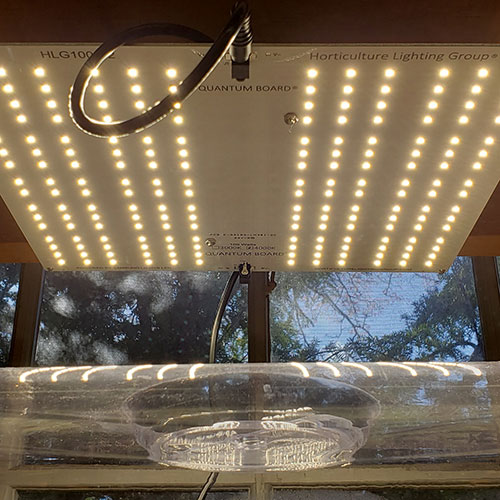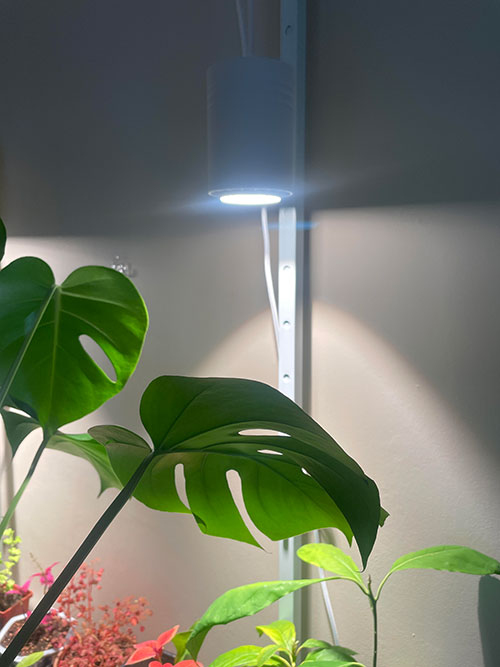Bulletin #2614, Tips for Growing Houseplants in Maine: Growing Houseplants Under Artificial Lights in Maine
Tips for Growing Houseplants in Maine: Caring for Houseplants in Maine (PDF)
Tips for Growing Houseplants in Maine: This newly revised and expanded fact sheet series addresses the basics of keeping houseplants. It will help you diagnose common problems with your houseplants, such as insects and diseases; overwatering or underwatering; improper lighting, temperature, or humidity; and insufficient pot size (root-bound). The series addresses how to start new plants from old plants, and also the unique challenges of growing houseplants in Maine, including the use of artificial light.
Adapted by Matt Wallhead, Extension Ornamental Horticulture Specialist, University of Maine Cooperative Extension
Reviewed by Donna Coffin, Extension Professor, and Rebecca Long, Extension Professional, University of Maine Cooperative Extension
For information about UMaine Extension programs and resources, visit extension.umaine.edu.
Find more of our publications and books at extension.umaine.edu/publications/.
Maine in winter is notoriously gray, but thanks to grow lights, houseplants are no longer limited to just windowsills. You can easily turn almost any part of your home into a greenhouse.
Why Use Grow Lights?
Insufficient light is one of the main reasons plants often grow and bloom poorly, have light-colored foliage, and spindly new growth. Inside a home, the light intensity varies by location. South-facing windows get the most amount of light, east-facing windows receive morning light, west-facing windows receive afternoon light, and north-facing windows get the least direct sunlight. The farther from a window or the smaller the window, the less light available. Also, the presence of trees or other obstructions outside a window, roof overhangs, and season of year will impact the amount of light in a room.
Grow lights are an excellent way to grow houseplants and can be used year-round. Grow lights (Figure 1) eliminate the problems associated with low light levels, because they make every day sunny as far as the plants are concerned. Grow lights can turn any poorly lit corner into a good area to grow plants. They also decrease temperature problems, because plants can be placed where they are not subject to winter’s cold or summer’s heat, as they are on window ledges.
Table 1 lists the typical light requirements for plants at various growth stages. Light is measured in photosynthetic photon flux density (PPFD) using a photosynthetically active radiation (PAR) meter. Several handheld meters and smartphone applications can quickly measure the light intensity of different areas.
| Growth Stage | Light Intensity (PPFD) |
|---|---|
| Seedling/Clone | Less than 100 |
| Vegetative | 100–500 |
| Flower/fruit | 400–1,200 |
What to Grow Under Lights
Most plants, both small and large, grow well under grow lights. Light emitting diodes (LEDs) are an excellent light for growing plants. LED lights can be installed just about anywhere in and around the home to supply full or supplemental lighting for plants.
Plants have different light requirements, or daily light integral (DLI). Daily light integral is the amount of photosynthetically active radiation (PAR) received over a duration of time or “photoperiod.” Think of DLI as light filling a bucket. You could turn the water on high and fill the bucket quickly, which would be likened to high light intensity for 12 hours or less. Or you could fill a bucket by allowing the water to trickle in over a longer period, which could be likened to growing seedlings under low intensity lights for 18 hours a day. Below is a table with recommended light levels for several common ornamental plant varieties.
| Plant | PPFD |
|---|---|
| African violets | 50–150 |
| Gloxinias | 100–400 |
| Herbs | 100–500 |
| Orchids | 40–500 |
| Philodendrons | 50–250 |
| Spring bulbs | 100–400 |
| Succulents | 100–200 |
When plants are too close to light, the petioles (leaf sterns) are short, and leaves are crinkled and perhaps leathery to the touch. When plants are too far away from light, the leaves are thin, internodes (space between the leaves) are much longer on new growth, new leaves are smaller and lighter green, and leaf petioles are long.
For large houseplants, a high intensity discharge (HID) light, such as an LED or metal halide at least 3 feet from the top of the plant will not cause a heat problem and will encourage good plant growth. You will have to experiment with light placement because conditions vary. Most plants will flourish if supplied with approximately 25 watts of light per square foot for LEDs. HID lights such as metal halide or high-pressure sodium would require about double the amount of wattage as an equivalent-sized LED. So, for a 1-sq-ft area you would want 50 watts of light. Intensity can be adjusted by changing how high the light is placed above the top of the plant canopy. One advantage of LEDs is that they are dimmable, with many models having a dial or switch that can be used to turn the brightness up or down.
Sixteen to 18 hours of artificial light a day is best for most plants. You can control the light period by hand or by installing a simple timer. Care for plants under artificial light as you would under natural conditions. Carefully monitor water needs, because plants dry out quickly when the house is heated, and humidity levels are low.
What You Will Need
Three main types of grow lights can be used for plants: fluorescent, LEDs, and HIDs. Primary considerations when purchasing are budget and heat management. T5 or T8 fluorescent lamps are moderately energy-efficient lights for seedlings, clone, and foliage plants, although this type of lighting is becoming outdated, similar to incandescent lighting in the 2010s. In T5, “T” stands for tubular-shaped and the “5” denotes that it is five-eighths inch in diameter. The slim bulb diameter and low heat output of fluorescent lamps are what make them an attractive choice for providing usable light to plants. If you are purchasing a new light, it would be best to purchase LEDs based on their energy efficiency and longevity.
LEDs are the most common lights for small houseplants (Figure 2). They are inexpensive to operate and give off little heat. Spectrum, or light color, will be determined by what type of light you choose to use. It is measured in Kelvin (K) and ranges from 1,000 to 10,000, with lower numbers appearing red and higher numbers appearing blue. The type of plant and its growth stage will determine the optimal spectrum of light. Typically, seedlings, clones, and vegetatively growing plants prefer a bluer spectrum, which would correspond to Kelvin values of 4,000–10,000. Flowering plants generally prefer a redder spectrum, corresponding to Kelvin values of 1,000–3,500K.
Purple, or “blurple,” lights are a combination of red and blue diodes that appear purple when lit. For optimal plant growth the best lighting balance remains “full-spectrum,” or white, lights.
HID lights, such as metal halide or high-pressure sodium, can be used for plants that require high light levels or if the light is being hung a considerable distance (5 or more feet) above the canopy of the plant. Metal halide lights are commonly used for vegetative or foliage plants; high-pressure sodium lights can be used to flower or fruit plants indoors. With a bit of research and the right lights, you can keep your houseplants healthy and thriving through the long dark Maine winter.
For specific questions about suitable lighting options for a given scenario, feel free to contact matthew.wallhead@maine.edu for more information.
Additional Resources
- Bulletin #2611, Caring for Houseplants in Maine
- Bulletin #2612, Dealing with Houseplant Problems in Maine
- Bulletin #2613, Controlling Insects and Disease in Houseplants
- Bulletin #2615, Creating New Plants from Old Plants
- Bulletin #2516, FAQ About Houseplants in Maine
Sources
Houseplants in Maine by Lois Stack, Ornamental Horticulture Specialist, University of Maine Cooperative Extension
House Plant Tips by Gleason Gray, Extension Educator, Penobscot County, University of Maine Cooperative Extension
Information in this publication is provided purely for educational purposes. No responsibility is assumed for any problems associated with the use of products or services mentioned. No endorsement of products or companies is intended, nor is criticism of unnamed products or companies implied.
© 2021
Call 800.287.0274 (in Maine), or 207.581.3188, for information on publications and program offerings from University of Maine Cooperative Extension, or visit extension.umaine.edu.
In complying with the letter and spirit of applicable laws and pursuing its own goals of diversity, the University of Maine System does not discriminate on the grounds of race, color, religion, sex, sexual orientation, transgender status, gender, gender identity or expression, ethnicity, national origin, citizenship status, familial status, ancestry, age, disability physical or mental, genetic information, or veterans or military status in employment, education, and all other programs and activities. The University provides reasonable accommodations to qualified individuals with disabilities upon request. The following person has been designated to handle inquiries regarding non-discrimination policies: Director of Equal Opportunity and Title IX Services, 5713 Chadbourne Hall, Room 412, University of Maine, Orono, ME 04469-5713, 207.581.1226, TTY 711 (Maine Relay System).



